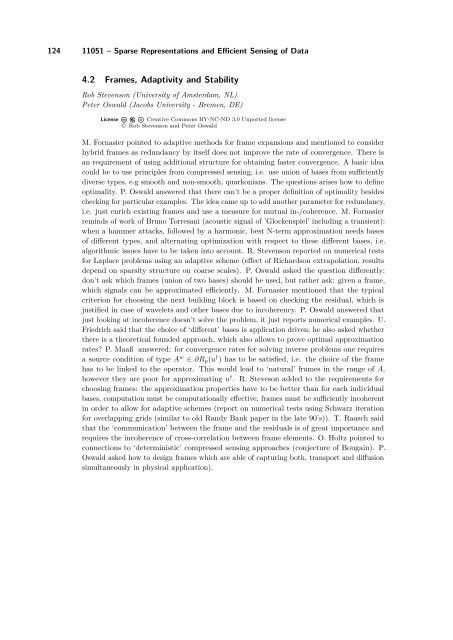Volume 1, Issue 1, January 2011 - DROPS - Schloss Dagstuhl
Volume 1, Issue 1, January 2011 - DROPS - Schloss Dagstuhl
Volume 1, Issue 1, January 2011 - DROPS - Schloss Dagstuhl
Create successful ePaper yourself
Turn your PDF publications into a flip-book with our unique Google optimized e-Paper software.
124 11051 – Sparse Representations and Efficient Sensing of Data<br />
4.2 Frames, Adaptivity and Stability<br />
Rob Stevenson (University of Amsterdam, NL)<br />
Peter Oswald (Jacobs University - Bremen, DE)<br />
License Creative Commons BY-NC-ND 3.0 Unported license<br />
© Rob Stevenson and Peter Oswald<br />
M. Fornasier pointed to adaptive methods for frame expansions and mentioned to consider<br />
hybrid frames as redundancy by itself does not improve the rate of convergence. There is<br />
an requirement of using additional structure for obtaining faster convergence. A basic idea<br />
could be to use principles from compressed sensing, i.e. use union of bases from sufficiently<br />
diverse types, e.g smooth and non-smooth, quarkonians. The questions arises how to define<br />
optimality. P. Oswald answered that there can’t be a proper definition of optimality besides<br />
checking for particular examples. The idea came up to add another parameter for redundancy,<br />
i.e. just enrich existing frames and use a measure for mutual in-/coherence. M. Fornasier<br />
reminds of work of Bruno Torresani (acoustic signal of ’Glockenspiel’ including a transient):<br />
when a hammer attacks, followed by a harmonic, best N-term approximation needs bases<br />
of different types, and alternating optimization with respect to these different bases, i.e.<br />
algorithmic issues have to be taken into account. R. Stevenson reported on numerical tests<br />
for Laplace problems using an adaptive scheme (effect of Richardson extrapolation, results<br />
depend on sparsity structure on coarse scales). P. Oswald asked the question differently:<br />
don’t ask which frames (union of two bases) should be used, but rather ask: given a frame,<br />
which signals can be approximated efficiently. M. Fornasier mentioned that the typical<br />
criterion for choosing the next building block is based on checking the residual, which is<br />
justified in case of wavelets and other bases due to incoherency. P. Oswald answered that<br />
just looking at incoherence doesn’t solve the problem, it just reports numerical examples. U.<br />
Friedrich said that the choice of ‘different’ bases is application driven; he also asked whether<br />
there is a theoretical founded approach, which also allows to prove optimal approximation<br />
rates? P. Maaß answered: for convergence rates for solving inverse problems one requires<br />
a source condition of type A w ∈ ∂Rp(u † ) has to be satisfied, i.e. the choice of the frame<br />
has to be linked to the operator. This would lead to ‘natural’ frames in the range of A,<br />
however they are poor for approximating u † . R. Steveson added to the requirements for<br />
choosing frames: the approximation properties have to be better than for each individual<br />
bases, computation must be computationally effective, frames must be sufficiently incoherent<br />
in order to allow for adaptive schemes (report on numerical tests using Schwarz iteration<br />
for overlapping grids (similar to old Randy Bank paper in the late 90’s)). T. Raasch said<br />
that the ‘communication’ between the frame and the residuals is of great importance and<br />
requires the incoherence of cross-correlation between frame elements. O. Holtz pointed to<br />
connections to ‘deterministic’ compressed sensing approaches (conjecture of Bougain). P.<br />
Oswald asked how to design frames which are able of capturing both, transport and diffusion<br />
simultaneously in physical application).













